CADILLAC ESCALADE ESV 2009 Owners Manual
Manufacturer: CADILLAC, Model Year: 2009, Model line: ESCALADE ESV, Model: CADILLAC ESCALADE ESV 2009Pages: 602, PDF Size: 5.18 MB
Page 181 of 602
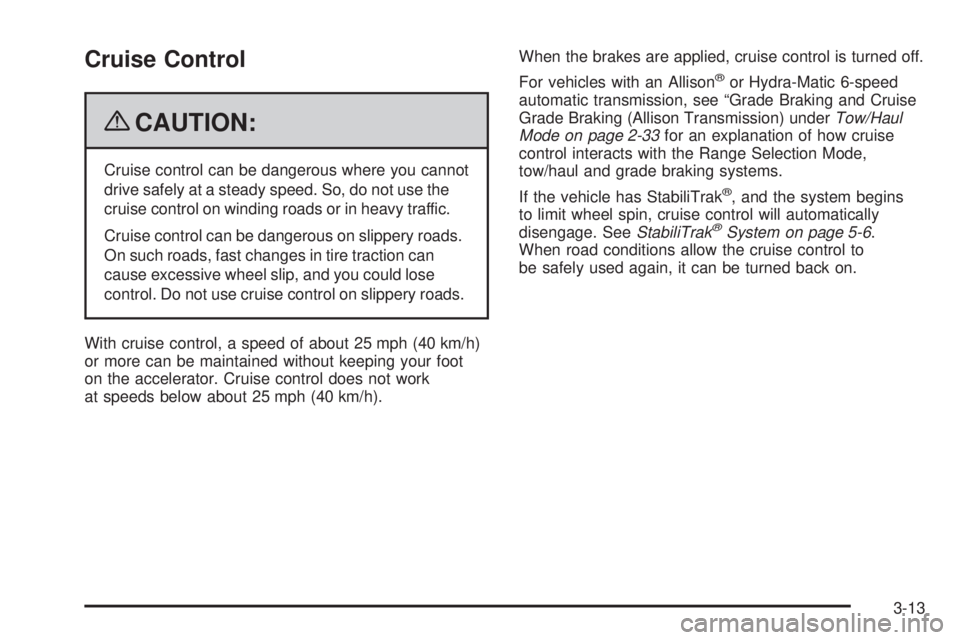
Cruise Control
{ CAUTION: Cruise control can be dangerous where you cannot
drive safely at a steady speed. So, do not use the
cruise control on winding roads or in heavy traffic.
Cruise control can be dangerous on slippery roads.
On such roads, fast changes in tire traction can
cause excessive wheel slip, and you could lose
control. Do not use cruise control on slippery roads.
With cruise control, a speed of about 25 mph (40 km/h)
or more can be maintained without keeping your foot
on the accelerator. Cruise control does not work
at speeds below about 25 mph (40 km/h). When the brakes are applied, cruise control is turned off.
For vehicles with an Allison ®
or Hydra-Matic 6-speed
automatic transmission, see “Grade Braking and Cruise
Grade Braking (Allison Transmission) under Tow/Haul
Mode on page 2-33 for an explanation of how cruise
control interacts with the Range Selection Mode,
tow/haul and grade braking systems.
If the vehicle has StabiliTrak ®
, and the system begins
to limit wheel spin, cruise control will automatically
disengage. See StabiliTrak ®
System on page 5-6 .
When road conditions allow the cruise control to
be safely used again, it can be turned back on.
3-13
Page 182 of 602
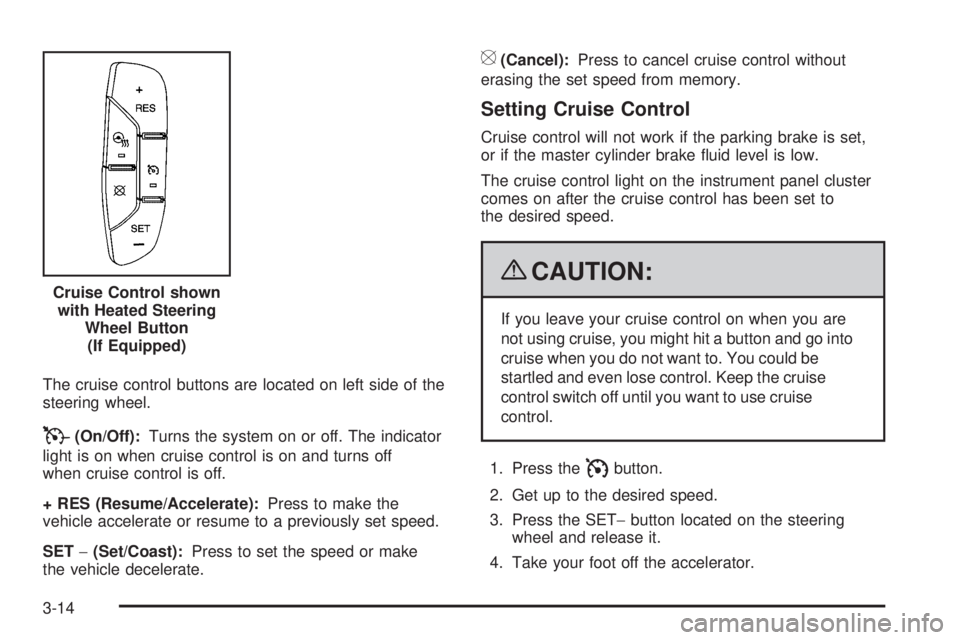
The cruise control buttons are located on left side of the
steering wheel.
T (On/Off): Turns the system on or off. The indicator
light is on when cruise control is on and turns off
when cruise control is off.
+ RES (Resume/Accelerate): Press to make the
vehicle accelerate or resume to a previously set speed.
SET − (Set/Coast): Press to set the speed or make
the vehicle decelerate. [ (Cancel): Press to cancel cruise control without
erasing the set speed from memory.
Setting Cruise Control Cruise control will not work if the parking brake is set,
or if the master cylinder brake �uid level is low.
The cruise control light on the instrument panel cluster
comes on after the cruise control has been set to
the desired speed.
{ CAUTION: If you leave your cruise control on when you are
not using cruise, you might hit a button and go into
cruise when you do not want to. You could be
startled and even lose control. Keep the cruise
control switch off until you want to use cruise
control.
1. Press the
I button.
2. Get up to the desired speed.
3. Press the SET − button located on the steering
wheel and release it.
4. Take your foot off the accelerator.Cruise Control shown
with Heated Steering
Wheel Button
(If Equipped)
3-14
Page 183 of 602
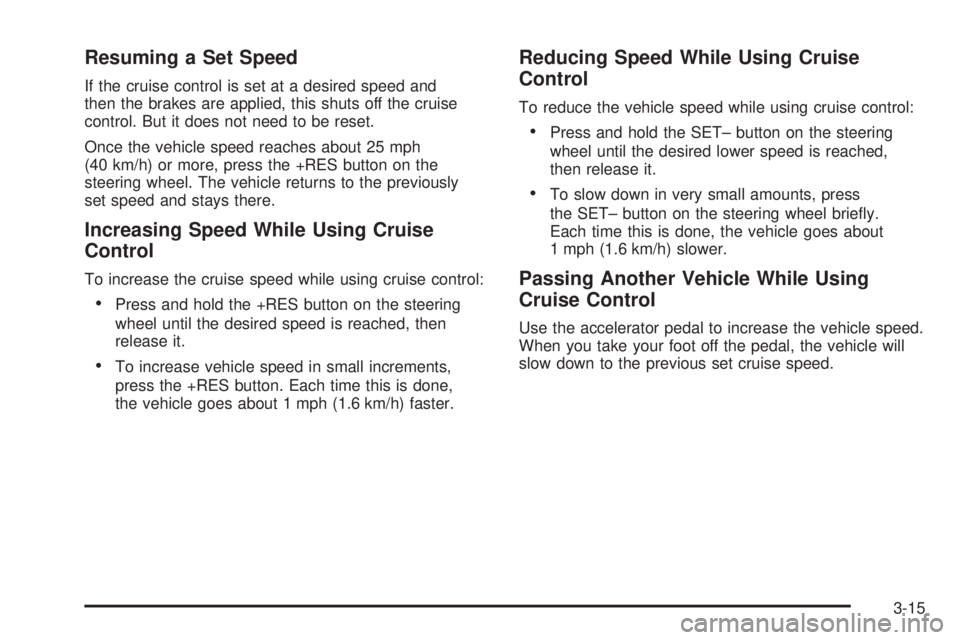
Resuming a Set Speed If the cruise control is set at a desired speed and
then the brakes are applied, this shuts off the cruise
control. But it does not need to be reset.
Once the vehicle speed reaches about 25 mph
(40 km/h) or more, press the +RES button on the
steering wheel. The vehicle returns to the previously
set speed and stays there.
Increasing Speed While Using Cruise
Control To increase the cruise speed while using cruise control:
Press and hold the +RES button on the steering
wheel until the desired speed is reached, then
release it.
To increase vehicle speed in small increments,
press the +RES button. Each time this is done,
the vehicle goes about 1 mph (1.6 km/h) faster. Reducing Speed While Using Cruise
Control To reduce the vehicle speed while using cruise control:
Press and hold the SET– button on the steering
wheel until the desired lower speed is reached,
then release it.
To slow down in very small amounts, press
the SET– button on the steering wheel brie�y.
Each time this is done, the vehicle goes about
1 mph (1.6 km/h) slower.
Passing Another Vehicle While Using
Cruise Control Use the accelerator pedal to increase the vehicle speed.
When you take your foot off the pedal, the vehicle will
slow down to the previous set cruise speed.
3-15
Page 184 of 602

Using Cruise Control on Hills How well the cruise control will work on hills depends
upon the vehicle speed, load, and the steepness of
the hills. When going up steep hills, you might have to
step on the accelerator pedal to maintain the vehicle’s
speed. When going downhill, you might have to brake
or shift to a lower gear to keep the vehicle’s speed
down. When the brakes are applied the cruise control
turns off.
Ending Cruise Control There are three ways to end cruise control:
Step lightly on the brake pedal.
Press the
[ button on the steering wheel.
Press the
I button on the steering wheel.
Erasing Speed Memory The cruise control set speed memory is erased when
the cruise control or the ignition is turned off. Exterior Lamps The exterior lamps control
is located on the instrument
panel to the left of the
steering wheel.
It controls the following systems:
Headlamps
Taillamps
Parking Lamps
License Plate Lamps
Instrument Panel Lights
3-16
Page 185 of 602

The exterior lamps control has four positions:
9 (Off): Turns off the automatic headlamps and
daytime running lamps (DRL). Turning the headlamp
control to the off position again will turn the automatic
headlamps or DRL back on.
For vehicles �rst sold in Canada, the off position only
works when the vehicle is shifted into the P (Park)
position.
AUTO (Automatic): Automatically turns on the
headlamps at normal brightness, together with the
following:
Parking Lamps
Instrument Panel Lights
Taillamps
License Plate Lamps
; (Parking Lamps): Turns on the parking lamps
together with the following:
Instrument Panel Lights
Taillamps
License Plate Lamps 2 (Headlamps): Turns on the headlamps together
with the following lamps listed below.
Parking Lamps
Instrument Panel Lights
Taillamps
License Plate Lamps
When the headlamps are turned on while the vehicle is
on, the headlamps will turn off automatically 10 minutes
after the ignition is turned off. When the headlamps
are turned on while the vehicle is off, the headlamps
will stay on for 10 minutes before automatically turning
off to prevent the battery from being drained. Turn the
headlamp control to off and then back to the headlamp
on position to make the headlamps stay on for an
additional 10 minutes.
3-17
Page 186 of 602
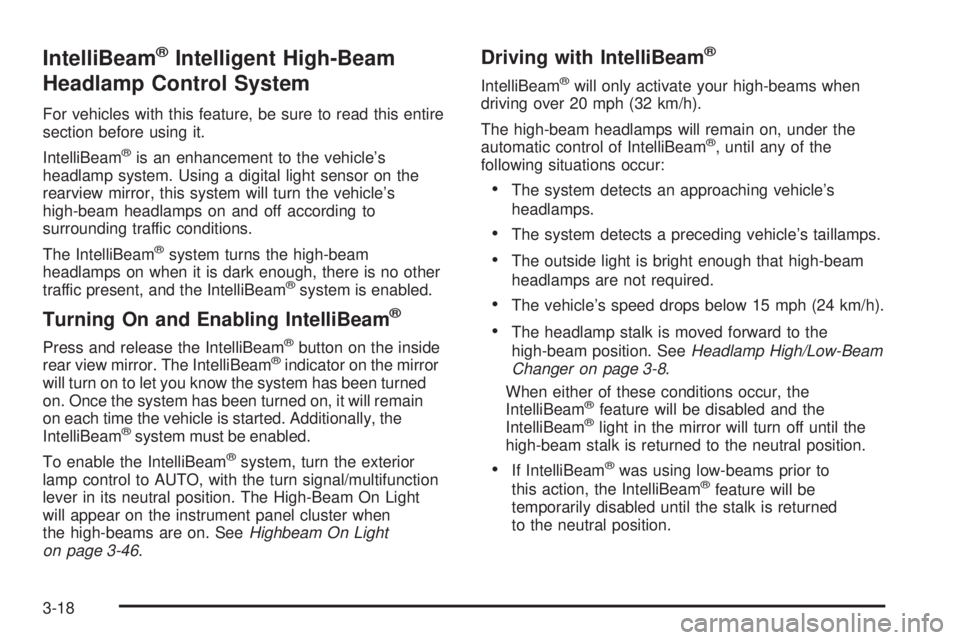
IntelliBeam ®
Intelligent High-Beam
Headlamp Control System For vehicles with this feature, be sure to read this entire
section before using it.
IntelliBeam ®
is an enhancement to the vehicle’s
headlamp system. Using a digital light sensor on the
rearview mirror, this system will turn the vehicle’s
high-beam headlamps on and off according to
surrounding traffic conditions.
The IntelliBeam ®
system turns the high-beam
headlamps on when it is dark enough, there is no other
traffic present, and the IntelliBeam ®
system is enabled.
Turning On and Enabling IntelliBeam ®
Press and release the IntelliBeam ®
button on the inside
rear view mirror. The IntelliBeam ®
indicator on the mirror
will turn on to let you know the system has been turned
on. Once the system has been turned on, it will remain
on each time the vehicle is started. Additionally, the
IntelliBeam ®
system must be enabled.
To enable the IntelliBeam ®
system, turn the exterior
lamp control to AUTO, with the turn signal/multifunction
lever in its neutral position. The High-Beam On Light
will appear on the instrument panel cluster when
the high-beams are on. See Highbeam On Light
on page 3-46 . Driving with IntelliBeam ®
IntelliBeam ®
will only activate your high-beams when
driving over 20 mph (32 km/h).
The high-beam headlamps will remain on, under the
automatic control of IntelliBeam ®
, until any of the
following situations occur:
The system detects an approaching vehicle’s
headlamps.
The system detects a preceding vehicle’s taillamps.
The outside light is bright enough that high-beam
headlamps are not required.
The vehicle’s speed drops below 15 mph (24 km/h).
The headlamp stalk is moved forward to the
high-beam position. See Headlamp High/Low-Beam
Changer on page 3-8 .
When either of these conditions occur, the
IntelliBeam ®
feature will be disabled and the
IntelliBeam ®
light in the mirror will turn off until the
high-beam stalk is returned to the neutral position.
If IntelliBeam ®
was using low-beams prior to
this action, the IntelliBeam ®
feature will be
temporarily disabled until the stalk is returned
to the neutral position.
3-18
Page 187 of 602
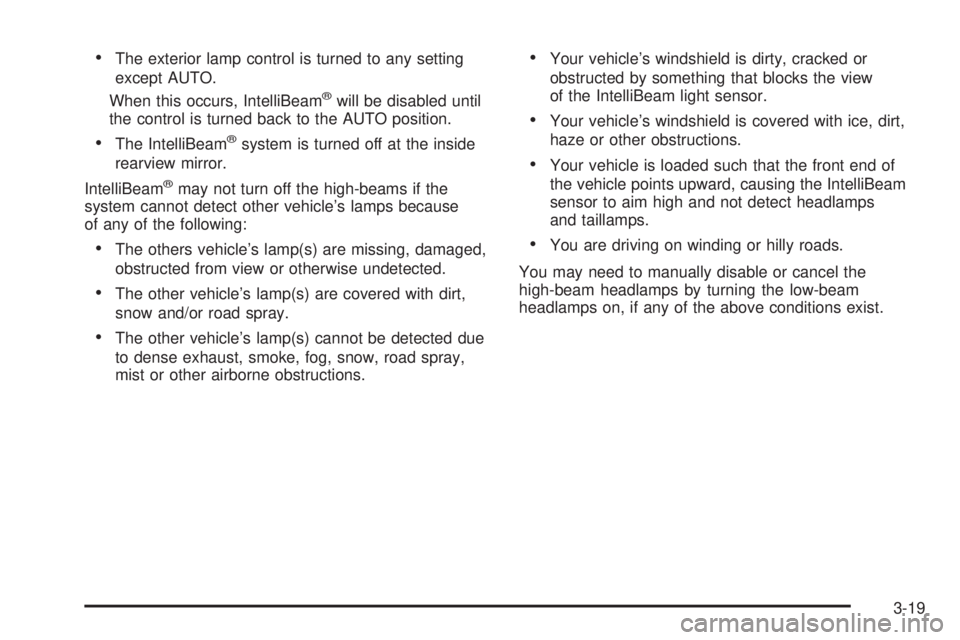
The exterior lamp control is turned to any setting
except AUTO.
When this occurs, IntelliBeam ®
will be disabled until
the control is turned back to the AUTO position.
The IntelliBeam ®
system is turned off at the inside
rearview mirror.
IntelliBeam ®
may not turn off the high-beams if the
system cannot detect other vehicle’s lamps because
of any of the following:
The others vehicle’s lamp(s) are missing, damaged,
obstructed from view or otherwise undetected.
The other vehicle’s lamp(s) are covered with dirt,
snow and/or road spray.
The other vehicle’s lamp(s) cannot be detected due
to dense exhaust, smoke, fog, snow, road spray,
mist or other airborne obstructions. Your vehicle’s windshield is dirty, cracked or
obstructed by something that blocks the view
of the IntelliBeam light sensor.
Your vehicle’s windshield is covered with ice, dirt,
haze or other obstructions.
Your vehicle is loaded such that the front end of
the vehicle points upward, causing the IntelliBeam
sensor to aim high and not detect headlamps
and taillamps.
You are driving on winding or hilly roads.
You may need to manually disable or cancel the
high-beam headlamps by turning the low-beam
headlamps on, if any of the above conditions exist.
3-19
Page 188 of 602
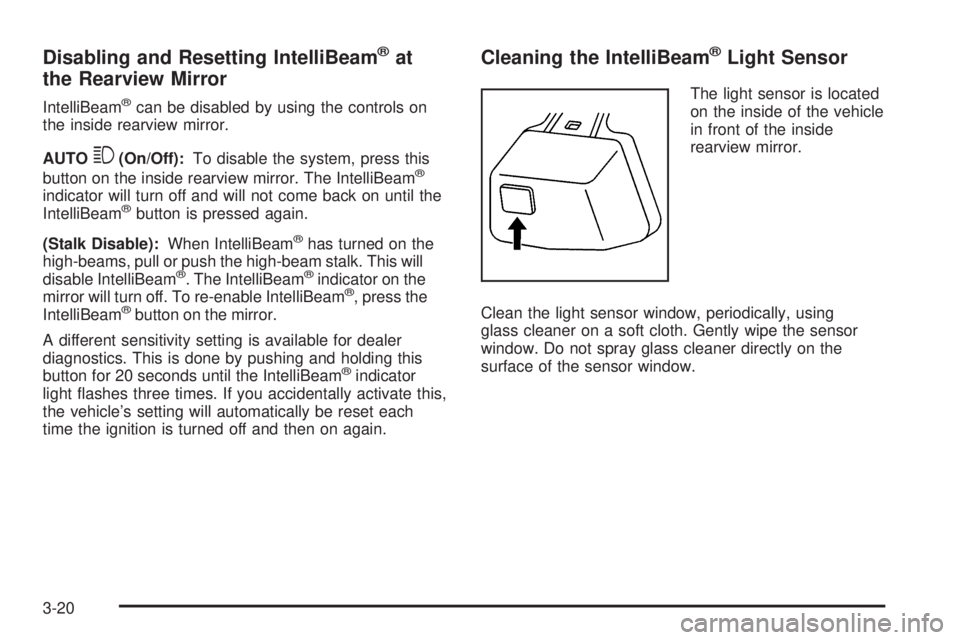
Disabling and Resetting IntelliBeam ®
at
the Rearview Mirror IntelliBeam ®
can be disabled by using the controls on
the inside rearview mirror.
AUTO
3 (On/Off): To disable the system, press this
button on the inside rearview mirror. The IntelliBeam ®
indicator will turn off and will not come back on until the
IntelliBeam ®
button is pressed again.
(Stalk Disable): When IntelliBeam ®
has turned on the
high-beams, pull or push the high-beam stalk. This will
disable IntelliBeam ®
. The IntelliBeam ®
indicator on the
mirror will turn off. To re-enable IntelliBeam ®
, press the
IntelliBeam ®
button on the mirror.
A different sensitivity setting is available for dealer
diagnostics. This is done by pushing and holding this
button for 20 seconds until the IntelliBeam ®
indicator
light �ashes three times. If you accidentally activate this,
the vehicle’s setting will automatically be reset each
time the ignition is turned off and then on again. Cleaning the IntelliBeam ®
Light Sensor The light sensor is located
on the inside of the vehicle
in front of the inside
rearview mirror.
Clean the light sensor window, periodically, using
glass cleaner on a soft cloth. Gently wipe the sensor
window. Do not spray glass cleaner directly on the
surface of the sensor window.
3-20
Page 189 of 602

Headlamps on Reminder If a door is open, a reminder chime will sound when
the headlamps or parking lamps are manually turned on
and the key is out of the ignition. To turn off the chime,
turn the headlamp switch to off or AUTO and then back
on, or close and re-open the door. In the AUTO mode,
the headlamps turn off once the ignition is in LOCK/OFF
or may remain on until the headlamp delay ends
(if enabled in the DIC). See “Exit Lighting” under
DIC Vehicle Customization on page 3-65 .
Daytime Running Lamps (DRL) Daytime Running Lamps (DRL) can make it easier
for others to see the front of your vehicle during the day.
Fully functional daytime running lamps are required
on all vehicles �rst sold in Canada.
The DRL system will come on when the following
conditions are met:
The ignition is on.
The exterior lamps control is in AUTO.
The transmission is not in P (Park).
The light sensor determines it is daytime.
When the DRL are on, only the DRL lamps will be on.
The taillamps, sidemarker, instrument panel lights,
and other lamps will not be on. When it begins to get dark, the automatic headlamp
system will switch from DRL to the headlamps.
To turn off the DRL lamps, turn the exterior
lamps control to the OFF position and then release.
For vehicles �rst sold in Canada, the transmission must
be in the P (Park) position, before the DRL lamps can
be turned off.
Automatic Headlamp System When it is dark enough outside, the automatic headlamp
system turns on the headlamps at the normal brightness,
along with the taillamps, sidemarker, parking lamps,
and the instrument panel lights. The radio lights will
also be dim.
To turn off the automatic headlamp system, turn the
exterior lamps switch to the off position and then release
it. For vehicles �rst sold in Canada, the transmission
must be in the P (Park) position, before the automatic
headlamp system can be turned off.
The vehicle has a light sensor located on the top of the
instrument panel in the defroster grille that regulates
when the automatic headlamps turn on. Do not cover
the sensor or the headlamps will come on whenever
the ignition is on.
The system may also turn on the headlamps when
driving through a parking garage, heavy overcast
weather, or a tunnel. This is normal.
3-21
Page 190 of 602

There is a delay in the transition between the daytime
and nighttime operation of the Daytime Running Lamps
(DRL) and the automatic headlamp systems so that
driving under bridges or bright overhead street lights
does not affect the system. The DRL and automatic
headlamp system is only affected when the light sensor
detects a change in lighting lasting longer than the delay.
If the vehicle is started in a dark garage, the automatic
headlamp system will come on immediately. Once the
vehicle leaves the garage, it takes approximately
one minute for the automatic headlamp system to
change to DRL if it is bright enough outside. During
that delay, the instrument panel cluster may not be
as bright as usual. Make sure the instrument panel
brightness control is in the full bright position.
See Instrument Panel Brightness on page 3-23 .
To idle the vehicle with the automatic headlamp system
off, turn the control to the off position.
The headlamps will also stay on after you exit the
vehicle. This feature can be programmed using the
Driver Information Center (DIC). See DIC Vehicle
Customization on page 3-65 .
The regular headlamp system can be turned on when
needed. Fog Lamps For vehicles with fog lamps, the control is located next
to the exterior lamps control on the instrument panel
to the left of the steering column.
# (Fog Lamps): Press the button to turn the fog lamps
on or off. A indicator light comes on in the instrument
panel cluster. The ignition must be in the ON/RUN
position for the fog lamps to come on.
When the fog lamps are turned on, the headlamps
automatically turn on.
When the headlamps are changed to high-beam, the
fog lamps also go off. When the high-beam headlamps
go off, the fog lamps will come on again.
Some localities have laws that require the headlamps to
be on along with the fog lamps.
3-22